2005 CHEVROLET AVEO seats
[x] Cancel search: seatsPage 1 of 316

Seats and Restraint Systems........................... 1-1
Front Seats
............................................... 1-2
Rear Seats
............................................... 1-6
Safety Belts
.............................................1-10
Child Restraints
.......................................1-27
Airbag System
.........................................1-46
Restraint System Check
............................1-53
Features and Controls..................................... 2-1
Keys
........................................................ 2-2
Doors and Locks
....................................... 2-7
Windows
.................................................2-12
Theft-Deterrent Systems
............................2-14
Starting and Operating Your Vehicle
...........2-17
Mirrors
....................................................2-32
Storage Areas
.........................................2-34
Sunroof
..................................................2-35
Instrument Panel............................................. 3-1
Instrument Panel Overview
.......................... 3-4
Climate Controls
......................................3-14
Warning Lights, Gages, and Indicators
........3-19
Secondary Information Center (SIC)
............3-25
Audio System(s)
.......................................3-33Driving Your Vehicle....................................... 4-1
Your Driving, the Road, and Your Vehicle
..... 4-2
Towing
...................................................4-34
Service and Appearance Care.......................... 5-1
Service
..................................................... 5-3
Fuel
......................................................... 5-5
Checking Things Under the Hood
...............5-10
Headlamp Aiming
.....................................5-39
Bulb Replacement
....................................5-40
Windshield Wiper Blade Replacement
.........5-46
Tires
......................................................5-47
Appearance Care
.....................................5-68
Vehicle Identification
.................................5-76
Electrical System
......................................5-76
Capacities and Specifications
.....................5-82
Normal Maintenance Replacement Parts
......5-83
Maintenance Schedule..................................... 6-1
Maintenance Schedule
................................ 6-2
Customer Assistance and Information.............. 7-1
Customer Assistance and Information
........... 7-2
Reporting Safety Defects
...........................7-10
Index................................................................ 1
2005 Chevrolet Aveo Owner ManualM
Page 4 of 316
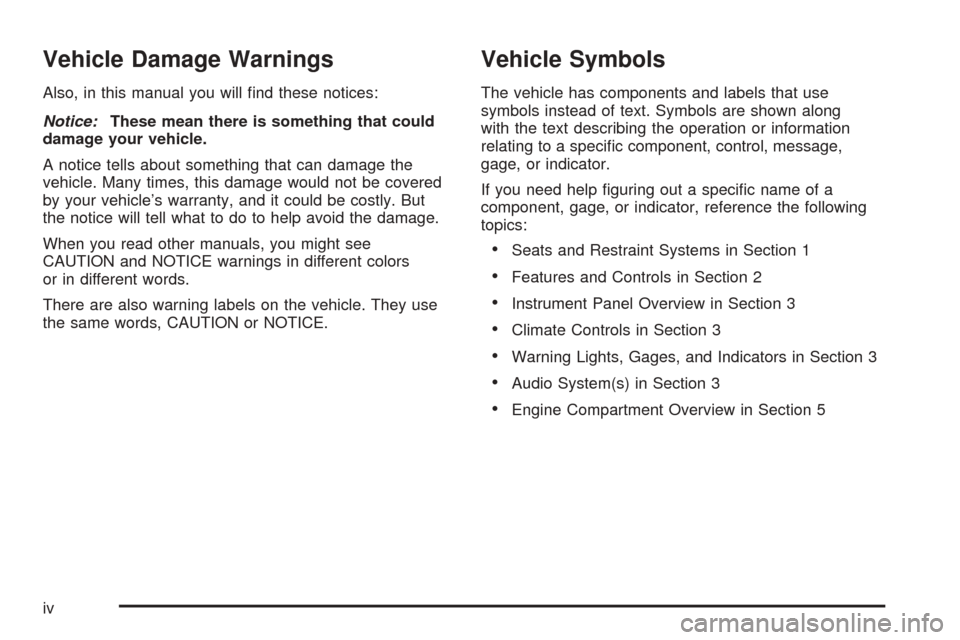
Vehicle Damage Warnings
Also, in this manual you will find these notices:
Notice:These mean there is something that could
damage your vehicle.
A notice tells about something that can damage the
vehicle. Many times, this damage would not be covered
by your vehicle’s warranty, and it could be costly. But
the notice will tell what to do to help avoid the damage.
When you read other manuals, you might see
CAUTION and NOTICE warnings in different colors
or in different words.
There are also warning labels on the vehicle. They use
the same words, CAUTION or NOTICE.
Vehicle Symbols
The vehicle has components and labels that use
symbols instead of text. Symbols are shown along
with the text describing the operation or information
relating to a specific component, control, message,
gage, or indicator.
If you need help figuring out a specific name of a
component, gage, or indicator, reference the following
topics:
•Seats and Restraint Systems in Section 1
•Features and Controls in Section 2
•Instrument Panel Overview in Section 3
•Climate Controls in Section 3
•Warning Lights, Gages, and Indicators in Section 3
•Audio System(s) in Section 3
•Engine Compartment Overview in Section 5
iv
Page 7 of 316
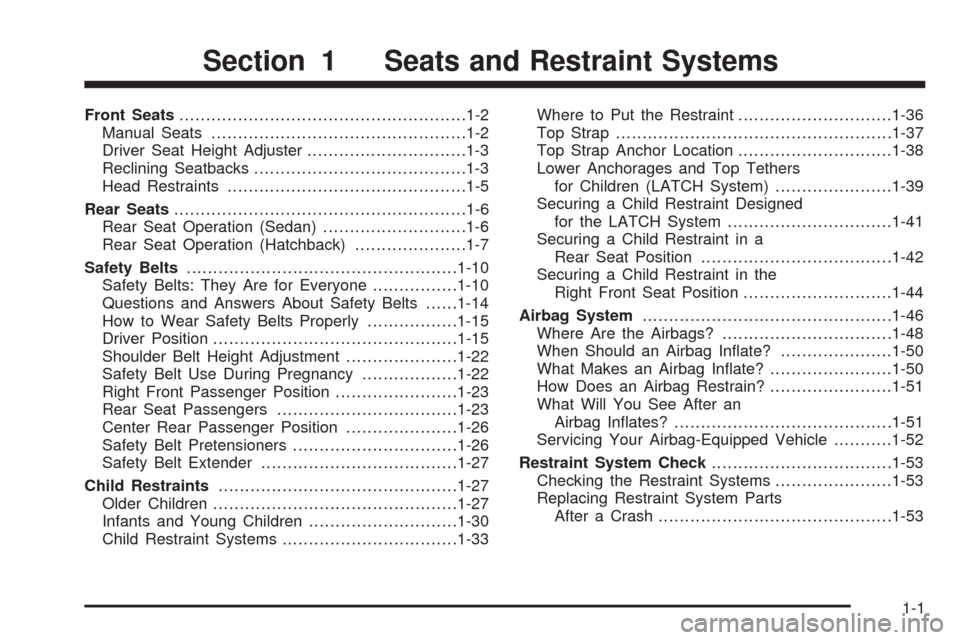
Front Seats......................................................1-2
Manual Seats................................................1-2
Driver Seat Height Adjuster..............................1-3
Reclining Seatbacks........................................1-3
Head Restraints.............................................1-5
Rear Seats.......................................................1-6
Rear Seat Operation (Sedan)...........................1-6
Rear Seat Operation (Hatchback).....................1-7
Safety Belts...................................................1-10
Safety Belts: They Are for Everyone................1-10
Questions and Answers About Safety Belts......1-14
How to Wear Safety Belts Properly.................1-15
Driver Position..............................................1-15
Shoulder Belt Height Adjustment.....................1-22
Safety Belt Use During Pregnancy..................1-22
Right Front Passenger Position.......................1-23
Rear Seat Passengers..................................1-23
Center Rear Passenger Position.....................1-26
Safety Belt Pretensioners...............................1-26
Safety Belt Extender.....................................1-27
Child Restraints.............................................1-27
Older Children..............................................1-27
Infants and Young Children............................1-30
Child Restraint Systems.................................1-33Where to Put the Restraint.............................1-36
Top Strap....................................................1-37
Top Strap Anchor Location.............................1-38
Lower Anchorages and Top Tethers
for Children (LATCH System)......................1-39
Securing a Child Restraint Designed
for the LATCH System...............................1-41
Securing a Child Restraint in a
Rear Seat Position....................................1-42
Securing a Child Restraint in the
Right Front Seat Position............................1-44
Airbag System...............................................1-46
Where Are the Airbags?................................1-48
When Should an Airbag Inflate?.....................1-50
What Makes an Airbag Inflate?.......................1-50
How Does an Airbag Restrain?.......................1-51
What Will You See After an
Airbag Inflates?.........................................1-51
Servicing Your Airbag-Equipped Vehicle...........1-52
Restraint System Check..................................1-53
Checking the Restraint Systems......................1-53
Replacing Restraint System Parts
After a Crash............................................1-53
Section 1 Seats and Restraint Systems
1-1
Page 8 of 316

Front Seats
Manual Seats
{CAUTION:
You can lose control of the vehicle if you try to
adjust a manual driver’s seat while the vehicle
is moving. The sudden movement could startle
and confuse you, or make you push a pedal
when you do not want to. Adjust the driver’s
seat only when the vehicle is not moving.Pull up and hold the bar
located under the front of
the seat to unlock it.
Slide the seat to where you want it and release the bar.
Then try to move the seat with your body, to make
sure the seat is locked into place.
1-2
Page 12 of 316
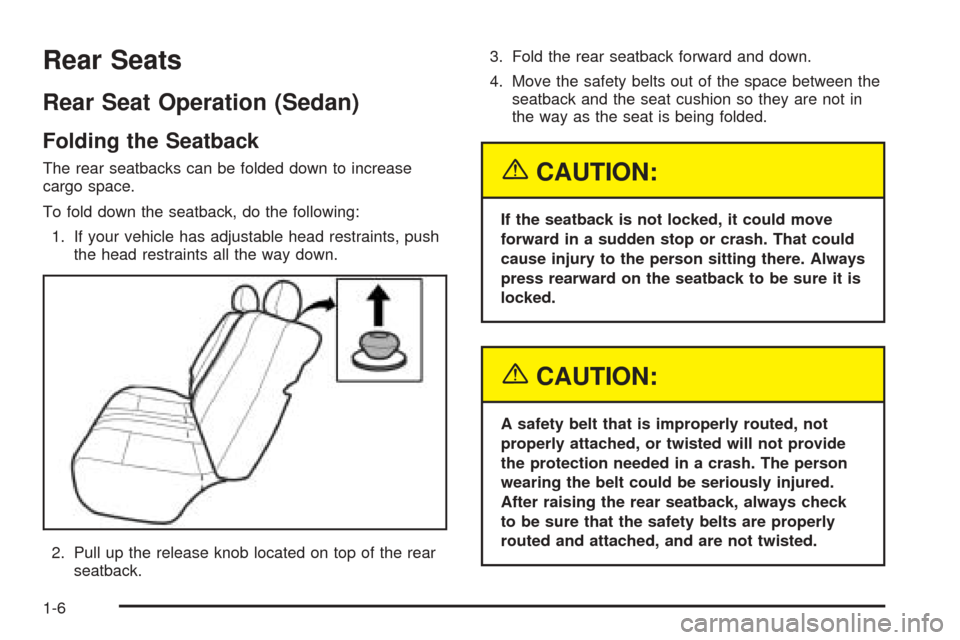
Rear Seats
Rear Seat Operation (Sedan)
Folding the Seatback
The rear seatbacks can be folded down to increase
cargo space.
To fold down the seatback, do the following:
1. If your vehicle has adjustable head restraints, push
the head restraints all the way down.
2. Pull up the release knob located on top of the rear
seatback.3. Fold the rear seatback forward and down.
4. Move the safety belts out of the space between the
seatback and the seat cushion so they are not in
the way as the seat is being folded.{CAUTION:
If the seatback is not locked, it could move
forward in a sudden stop or crash. That could
cause injury to the person sitting there. Always
press rearward on the seatback to be sure it is
locked.
{CAUTION:
A safety belt that is improperly routed, not
properly attached, or twisted will not provide
the protection needed in a crash. The person
wearing the belt could be seriously injured.
After raising the rear seatback, always check
to be sure that the safety belts are properly
routed and attached, and are not twisted.
1-6
Page 16 of 316
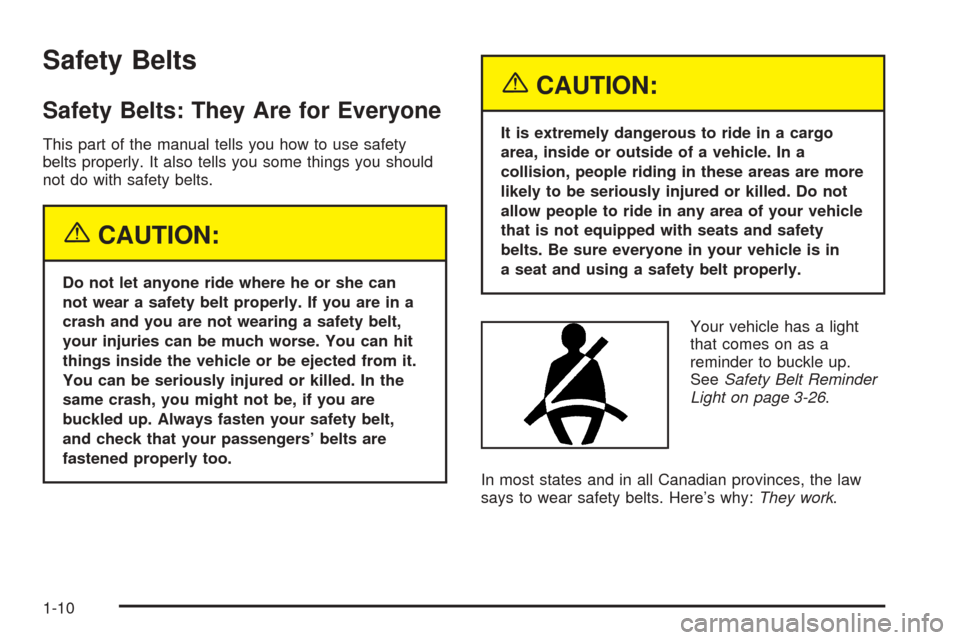
Safety Belts
Safety Belts: They Are for Everyone
This part of the manual tells you how to use safety
belts properly. It also tells you some things you should
not do with safety belts.
{CAUTION:
Do not let anyone ride where he or she can
not wear a safety belt properly. If you are in a
crash and you are not wearing a safety belt,
your injuries can be much worse. You can hit
things inside the vehicle or be ejected from it.
You can be seriously injured or killed. In the
same crash, you might not be, if you are
buckled up. Always fasten your safety belt,
and check that your passengers’ belts are
fastened properly too.
{CAUTION:
It is extremely dangerous to ride in a cargo
area, inside or outside of a vehicle. In a
collision, people riding in these areas are more
likely to be seriously injured or killed. Do not
allow people to ride in any area of your vehicle
that is not equipped with seats and safety
belts. Be sure everyone in your vehicle is in
a seat and using a safety belt properly.
Your vehicle has a light
that comes on as a
reminder to buckle up.
SeeSafety Belt Reminder
Light on page 3-26.
In most states and in all Canadian provinces, the law
says to wear safety belts. Here’s why:They work.
1-10
Page 21 of 316
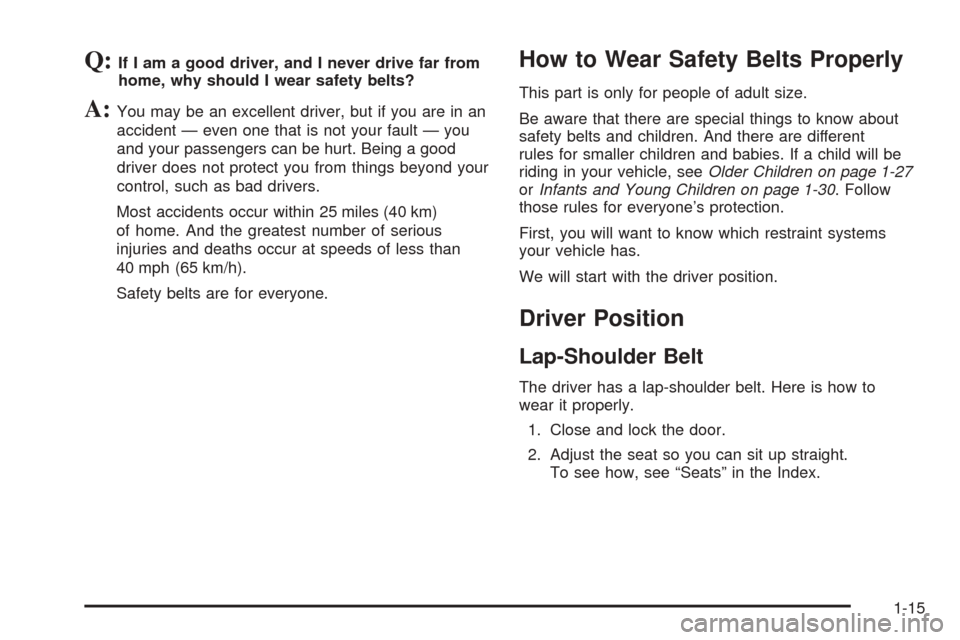
Q:If I am a good driver, and I never drive far from
home, why should I wear safety belts?
A:You may be an excellent driver, but if you are in an
accident — even one that is not your fault — you
and your passengers can be hurt. Being a good
driver does not protect you from things beyond your
control, such as bad drivers.
Most accidents occur within 25 miles (40 km)
of home. And the greatest number of serious
injuries and deaths occur at speeds of less than
40 mph (65 km/h).
Safety belts are for everyone.
How to Wear Safety Belts Properly
This part is only for people of adult size.
Be aware that there are special things to know about
safety belts and children. And there are different
rules for smaller children and babies. If a child will be
riding in your vehicle, seeOlder Children on page 1-27
orInfants and Young Children on page 1-30. Follow
those rules for everyone’s protection.
First, you will want to know which restraint systems
your vehicle has.
We will start with the driver position.
Driver Position
Lap-Shoulder Belt
The driver has a lap-shoulder belt. Here is how to
wear it properly.
1. Close and lock the door.
2. Adjust the seat so you can sit up straight.
To see how, see “Seats” in the Index.
1-15
Page 33 of 316
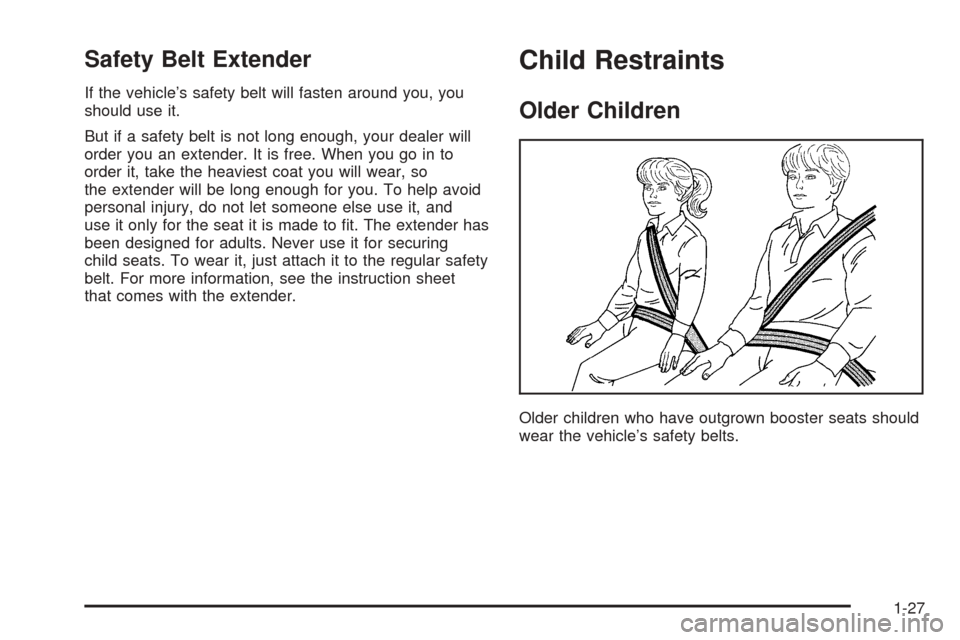
Safety Belt Extender
If the vehicle’s safety belt will fasten around you, you
should use it.
But if a safety belt is not long enough, your dealer will
order you an extender. It is free. When you go in to
order it, take the heaviest coat you will wear, so
the extender will be long enough for you. To help avoid
personal injury, do not let someone else use it, and
use it only for the seat it is made to fit. The extender has
been designed for adults. Never use it for securing
child seats. To wear it, just attach it to the regular safety
belt. For more information, see the instruction sheet
that comes with the extender.
Child Restraints
Older Children
Older children who have outgrown booster seats should
wear the vehicle’s safety belts.
1-27